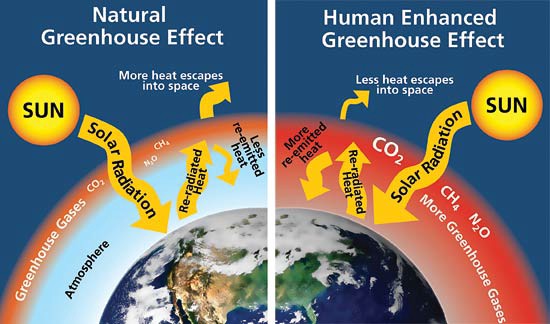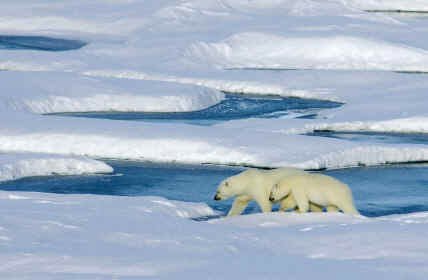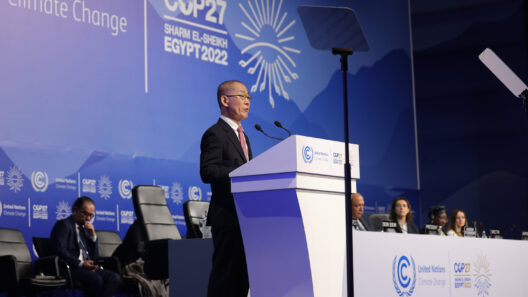In the intricate tapestry of Earth’s climate system, greenhouse gases (GHGs) weave an invisible cocoon that is both essential for maintaining life and perilous in its abundance. To truly grasp how greenhouse gases induce global warming, one must delve into the delicate balance of Earth’s atmospheric dynamics and recognize the duality of their existence—a dichotomy that casts them as both protectors and destroyers.
At the heart of this phenomenon lies the greenhouse effect, an elegant yet formidable process that allows life to flourish. Imagine the Earth as a cozy abode, where sunlight casts through the windows, warming the interior. Greenhouse gases resemble the glass panes, letting sunlight in while trapping some of the warmth within. Without these gases—carbon dioxide (CO2), methane (CH4), nitrous oxide (N2O), and others—our planet would plunge into a deep freeze, making it inhospitable for most life forms. However, as human activities release GHGs in unprecedented volumes, this once-favorable insulation transforms into an oppressive shroud, intensifying the heat that courses through the atmosphere.
Scientific scrutiny reveals that GHGs absorb and re-radiate infrared radiation—energy released from the Earth’s surface back towards space. This process is akin to a feedback loop; the more GHGs present, the more heat is trapped, leading to a steady rise in global temperatures. Over the past century, common activities such as burning fossil fuels, deforestation, and industrial processes have unleashed copious amounts of these gases into the atmosphere. The causal relationship here is clear: increase the concentration of GHGs, and you invariably elevate the Earth’s temperature.
To understand the gravity of the situation, consider the individual contributions of various greenhouse gases. Carbon dioxide, the most prolific of these gases, is predominantly released through combustion processes—whether from vehicles, power plants, or deforestation. Methane, a gas with a potency more than twenty-five times that of CO2 over a century, is released during the production and transport of coal, oil, and natural gas, as well as from agricultural practices and landfills. Nitrous oxide, while less abundant, is far more effective at trapping heat and is primarily emitted from agricultural and industrial activities, as well as during combustion of fossil fuels and solid waste. Each of these gases plays a distinct role in the complex orchestration of global warming, with their impacts persisting in the atmosphere for varying time scales.
The consequences of heightened greenhouse gas concentrations extend far beyond mere temperature fluctuations. The warming atmosphere disrupts local climates, leading to extreme weather patterns. Hurricanes become more intense, heatwaves more frequent, and droughts lengthen, devastating agricultural yields and threatening food security. Ice caps and glaciers retreat at unprecedented rates, contributing to rising sea levels, which encroach upon coastal communities and exacerbate flooding risks. Terrestrial and marine ecosystems suffer drastically as species struggle to adapt to rapid changes, leading to biodiversity loss at an alarming rate.
This invisible threat, cloaked in a veil of scientific terminology, becomes readily apparent when one observes the synchronized dance of natural systems responding to climatic changes. Coral reefs, once vibrant ecosystems, bleached into ghostly structures, symbolize the delicate balance that is shifting perilously. Famous climate phenomena, like El Niño, become more unpredictable, impacting weather patterns on a global scale, throwing humanity into disarray.
Moreover, the social implications of global warming driven by greenhouse gas emissions cannot be overlooked. Vulnerable populations around the world bear the brunt of climate change, grappling with the exacerbated effects of food scarcity, water shortages, and health risks. The burden falls disproportionately on those who contribute the least to the problem—often marginalized communities without the resources to adapt or mitigate these impacts. The ethical considerations provoke a moral reflection on humanity’s responsibilities toward one another and the planet we inhabit.
The urgency to address greenhouse gas emissions is amplified by the stark reality of our dependency on fossil fuels coupled with a growing global population. Transitioning to renewable energy sources, enhancing energy efficiency, and adopting sustainable land use practices are paramount steps toward mitigating the escalating menace of global warming. These solutions, while promising, necessitate collective action on an unprecedented scale, transcending borders and fostering collaboration among nations, industries, and individuals alike.
Education emerges as a formidable tool in combating greenhouse gas emissions. By instilling a deeper understanding of the science behind global warming and its consequences among people of all ages, society can cultivate an informed citizenry ready to engage in advocacy and policy change. Communicating the intricacies of climate science in relatable and intelligible terms will foster a sense of urgency, encouraging proactive measures at both individual and collective levels.
In closing, greenhouse gases represent an invisible thread intricately woven into the fabric of our global climate system. They remind us of our responsibility to maintain the balance necessary for life while cautioning against the perils of excess. The road ahead is fraught with challenges, but with concerted efforts, innovative thinking, and a resolute commitment to sustainability, humanity has the potential to emerge as a force for change, addressing the invisible threat of global warming before it irreversibly alters the landscape of our planet.








